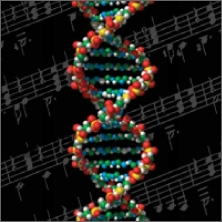
Plain language version: We compared DNA samples from 261 choral singers and 258 non-musicians, looking at the SLC6A4 and AVPR1A genes. Each codes for a protein important for communication between brain cells, specifically communication involving the chemical serotonin. In earlier studies, variation between individuals in these genes has been linked to differences in their emotional, behavioural and musical characteristics. At one point in the SLC6A4 gene, called the STIn2 VNTR, three main variants are seen in the general population; a 9-repeat, 10-repeat and 12-repeat. We found the 9-repeat and 12-repeat were more common in singers than non-musicians, and the 10-repeat less so. Further studies are required to confirm this finding and, if they do, to help establish whether the difference between choral singers and non-musicians relates to effects of the gene on behaviour or musical ability.
Summary from published scientific paper: "Amateur choral singing is a common pastime and worthy of study, possibly conferring benefits to health and social behaviour. Participants might be expected to possess musical ability and share some behavioural characteristics. Polymorphisms in genes concerned with serotonergic neurotransmission are associated with both behaviour and musical aptitude. Those investigated previously include the variable number tandem repeats RS1, RS3 and AVR in the AVPR1A (arginine vasopressin receptor 1a) gene and STin2 in the SLC6A4 (solute carrier family 6 [neurotransmitter transporter, serotonin], member 4) gene, as well as the SLC6A4 promoter region polymorphism, 5-HTTLPR. We conducted a genetic association study on 523 participants to establish whether alleles at these polymorphisms occur more commonly in choral singers than in those not regularly participating in organised musical activity (non-musicians). We also analysed tagging single nucleotide polymorphisms (SNPs) for AVPR1A and SLC6A4 to determine whether other variants in these genes were associated with singer/non-musician status. At the STin2 polymorphism, overall association with singer/non-musician status was evident at P = 0.006. The 9-repeat (P = 0.04) and 12-repeat (P = 0.04) alleles were more common in singers and the 10-repeat allele less so (P = 0.009). Odds ratios were 0.73 (95% CI 0.57 – 0.94) for the 10-repeat allele and 2.47 (95% CI 0.88-6.94) for the rarer 9-repeat allele. No overall association was detected at P < 0.05 between any other polymorphism and singer/non-musician status. Our null findings with respect to RS3, RS1 and AVR, polymorphisms associated with musical ability by other authors, suggest that choir membership may depend partly on factors other than musical ability…."
The full scientific paper, which includes discussion of the results and their implications, is available free in the open-access journal PLoS One.
http://www.plosone.org/article/info%3Adoi%2F10.1371%2Fjournal.pone.0031763
![]()
